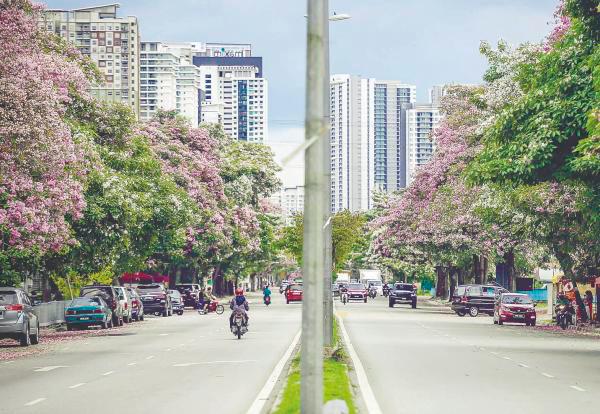LATELY, we have been experiencing numerous incidents of urban trees falling due to extreme weather conditions, leading to loss of life, injuries and significant property damage.
Notable occurrences were reported in Kuala Lumpur, Penang, Alor Setar and Nilai. In response, Kuala Lumpur City Hall (KL City Hall) has taken proactive measures by identifying 175 high-risk trees, most of which are over 50 years old, and cutting down 147 of them.
Regular inspections by certified arborists have identified 28 additional high-risk trees slated for removal.
Urban trees are essential to urban planning, providing environmental, social, economic, psychological and educational benefits. They improve air quality, support biodiversity, manage water resources, regulate temperatures, sequester carbon and enhance community well-being.
Trees also add aesthetic value, promote recreation, foster social cohesion, lead to energy savings, boost property values and contribute to psychological well-being, fostering a deep connection to nature, especially for children.
Given these multifaceted benefits, municipal landscape departments must ensure proper growth and structural development, including identifying and replacing unhealthy trees when needed.
Landscape architects and designers face critical tasks such as addressing site availability, soil conditions, species selection, growth requirements and maintenance to integrate street trees effectively.
Despite these challenges, urban trees play a vital role in climate change adaptation by reducing temperatures by up to 8°C, mitigating urban heat islands and managing stormwater, crucial for preventing urban flooding during heavy rainfall.
In response to these challenges, KL City Hall is enhancing its Shade Tree Management Plan and preparing new guidelines for managing old and high-risk trees, expected to be completed by July. However, there is a need for a broader enhancement of the National Plan, shifting from mere mitigation to comprehensive adaptation strategies.
Globally, cities are developing innovative solutions for climate adaptation, including Paris in France, Medellin in Colombia and Wuhan in China.
Nature-based Solutions (NbS) are at the forefront of globally recommended strategies. In 2020, Penang’s nature-based approach to tackling climate change, led by Think City and the Penang Island City Council, won the Climathon Global Awards for the best climate project by a global city that year.
This initiative has paved the way for further studies on climate-resilient urban tree species in Malaysia, and the execution of the Penang Nature-based Climate Adaptation Programme has since been launched.
Exploratory research by Think City indicated that urban tree species in Malaysia are already being affected by climate change. Understanding the resilience of different tree species to various climate impacts is critical for species selection.
This study emphasised the necessity of selecting climate-resilient tree species, considering factors such as habitat specialisation; saltwater intrusion; inundation, high-temperature, storm and water absence tolerance; humidity requirements; and susceptibility to predation, parasitism and disease.
Choosing the right tree for the right location is vital to ensure their longevity and functionality in urban environments, focusing on appropriate landscape typologies such as urban streets, small green spaces, blue-green corridors and seafronts.
Expanding knowledge about resilient tree species for urban planting is crucial for better-informed urban forest management decisions.
Collaboration among arborists, botanists, landscape architects, urban planners and the National Landscape Department is crucial.
The government should allocate sufficient funding to enhance the effectiveness of existing tree-planting campaigns, promoting more efficient tree-planting and maintenance efforts.
Implementing protective measures during the early years, such as adequately-sized tree pits with high-quality soil, root barriers and permeable pavements, and requiring a two-year maintenance period for newly planted trees by developers or responsible parties, will contribute to a more resilient and adaptive urban forestry strategy in Malaysia, ensuring the sustainability and safety of urban environments amid climate change challenges.
Addressing the surge of tree falls amid rising climate challenges requires a comprehensive approach that balances historical preservation, environmental benefits, climate adaptation and public safety.
The proactive measures undertaken by KL City Hall, including the identification and removal of high-risk trees, are immediate steps. However, as climate change continues to exacerbate extreme weather conditions, a more comprehensive and national adaptive strategy is required.
NbS offers a promising pathway for urban resilience. By learning from global examples and investing in local research, Malaysia can promote climate-resilient tree species through collaboration among arborists, botanists, landscape architects and government bodies.
Ultimately, the future of Malaysia’s urban landscapes hinges on our ability to adapt and innovate in the face of climate change.
By prioritising ecological sustainability and public safety, Malaysia can protect its green infrastructure, preserve its cultural heritage and ensure the well-being of its urban populations.
This holistic approach will not only reduce the risks of tree falls but also enhance the liveability and resilience of Malaysian cities for generations to come.
The writer is the managing director of Think City. Comments: letters@thesundaily.com









